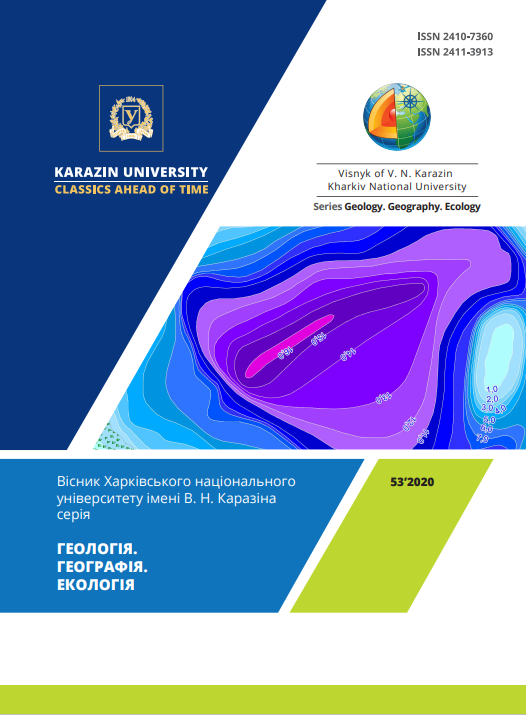Прогностичний розподіл посух теплого сезону по території України в 2021-2050 рр.
Анотація
В даній статті представлені результати аналізу просторово-часового розподілу посух в теплі сезони періоду 2021-2050 рр. по території України, отримані з використанням даних кліматичного моделювання в рамках кліматичних сценаріїв RCP4.5 та RCP6.0. Оцінка подій посух та їх інтенсивності виконана на базі стандартизованого індексу посух SPEI на масштабі 7 місяців, який охоплює теплий період року з квітня по жовтень. Аналіз прогностичного часового ходу індексу посух по регіонах країни показав, що за обома сценаріями спостерігатиметься тенденція до переходу від помірно вологих умов у 2021-2035 рр. до посушливих умов у 2037-2050 рр. При цьому в рамках сценарію RCP6.0 прогнозується більш тривалий перехід протягом 2030-х років з високою просторовою мінливістю індексу посух в цей період. Найбільш посушливими за обома сценаріями очікуються 2044-2048 рр., коли в ряді областей сезонна посуха може досягнути екстремальної інтенсивності. Встановлено, що в рамках обох сценаріїв очікується збільшення кількості сезонів з посухою протягом досліджуваного періоду, при цьому, на відміну від сценарію RCP4.5, за сценарієм RCP6.0 максимум повторюваності посух в другій половині періоду не зосереджений лише на півдні, а прогнозується також в східних і північних областях, що свідчить про суттєві просторові зміни прогнозованого характеру регіональної циркуляції атмосфери в рамках більш жорсткого сценарію. Кількість сезонів з посухою коливатиметься в різних областях від 2-3 випадків/10 років на початку досліджуваного періоду до 6-10 випадків/10 років наприкінці періоду. За обома сценаріями, максимум повторюваності сезонів з посухою в 2021-2030 рр. припадатиме на західні області України, при цьому в рамках сценарію RCP4.5 в південних областях в цей період посух майже не прогнозується. В період 2031-2040 рр. зростання кількості сезонів з посухою в середньому до 4-6 випадків/10 років відбуватиметься по всіх регіонах, окрім західних областей в рамках сценарію RCP6.0. В останнє десятиліття 2041-2050 рр. триватиме зростання посушливості, при цьому за сценарієм RCP6.0 кількість посушливих сезонів загалом по Україні очікується більшою, ніж в сценарії RCP4.5.
Завантаження
Посилання
Klimat Ukrainy [Climate of Ukraine]. (2003). Za red. V.M. Lipins'kogo, V.A. Dyachuka, V. M. Babíchenko. Kyiv: Vid. Raevs'kogo, 343.
Spinoni, J., Naumann, G., Vogt, J., Barbosa, P. (2016). Meteorological Droughts in Europe: Events and Impacts – Past Trends and Future Projections. Publications Office of the European Union, Luxembourg, EUR 27748 EN https://dx.doi.org/10.2788/450449
Spinoni, J., Naumann, G., Vogt, J. (2017). Pan-European seasonal trends and recent changes of drought frequency and severity. Global and Planetary Change, 148, 113–130 https://doi.org/10.1016/j.gloplacha.2016.11.013
Caloiero, T., Veltri, S., Caloiero, P., Frustaci, F. (2018). Drought Analysis in Europe and in the Mediterranean Basin Using the Standardized Precipitation Index. Water, 10, 1043 https://doi.org/10.3390/w10081043
Semenova I.H. (2017). Sinoptichni ta klimatichni umovi formuvannya posukh v Ukraini. [Synoptic and climatic conditions for the formation of droughts in Ukraine]. Kharkiv: FOP Panov A.M., 236.
Semenova, I., Sumak, K. (2017). Cyclonic activity in cold season over territories of Belarus and Ukraine and its relation to the warm season droughts. Croatian Meteorological Journal, 52 (52), 59-73.
IPCC (2013). Climate Change 2013: The Physical Science Basis. Contribution of WG I to the 5th Assessment Re-port of the IPCC [Stocker, T.F., et al. (eds.)]. Cambridge University Press, Cambridge, UK and New York, NY, USA, 1535.
Semenova, I.H., Introligator, O.A. (2018). Tendentsiy maybutniy zmin u rezhimi opadiv v Ukraini v litniy period 2020-2050 rr. [Trends of future changes in the precipitation in Ukraine in the summer 2020-2050]. Geografíya ta turizm, 42, 132-142.
McKee, T.B., Doesken, N.J., Kliest, J. (1993). The relationship of drought frequency and duration to time scales. Proceedings of the 8th Conference on Applied Climatology. Anaheim (USA), 179-184.
Svoboda, M., Hayes, M., Wood, D. (2012). Standardized Precipitation Index User Guide. WMO - No. 1090. Geneva, 17.
Semenova I.H. (2015). Prostranstvenno-vremennoye raspredeleniye zasukh v Ukraine v usloviyakh budushchego izmeneniya klimata. [Spatiotemporal distribution of droughts in Ukraine under conditions of future climate change]. Fizicheskaya geografiya i geomorfologiya, 1 (77), 144-151.
Semenova I.Н. (2016). Otsenka prostranstvenno-vremennogo raspredeleniya zasukh v Zakarpatskom regione v kratkosrochnoy perspektive do 2050 goda. [Estimation of the spatiotemporal distribution of droughts in the Transcarpathian region in the short term until 2050]. Ukrainskiy gidrometeorologicheskiy zhurnal, 18, 62-68.
Guerreiro, S.B., Dawson, R.J., Kilsby, C., Lewis E., Ford, A. (2018). Future heat-waves, droughts and floods in 571 European cities. Environ. Res. Lett. 13, 3 034009. https://doi.org/10.1088/1748-9326/aaaad3 .
Vicente-Serrano, S.M., Beguería, S., López-Moreno, J.I. (2010). A multiscalar drought index sensitive to global warming: the standardized precipitation evapotranspiration index. Jornal of Climate, 23 (7), 1696–1718.
Beguería, S., Vicente‐Serrano, S.M., Reig, F. and Latorre, B. (2014). Standardized precipitation evapotranspira-tion index (SPEI) revisited: parameter fitting, evapotranspiration models, tools, datasets and drought monitoring. Int. J. Climatol., 34, 3001-3023. https://doi.org/10.1002/joc.3887
Svoboda, M., Fuchs, B.A. (2016). Handbook of Drought Indicators and Indices. Integrated Drought Management Programme (IDMP), Integrated Drought Management Tools and Guidelines Series 2. Geneva, 46.
Abramopoulos, F., Rosenzweig, C., Choudhury, B. (1988). Improved ground hydrology calculations for global cli-mate models (GCMs): Soil water movement and evapotranspiration. Journal of Climate, 1, 921–941.
Thornthwaite, C.W., Mather, J.R. (1957). Instructions and tables for computing potential evapotranspiration and the water balance. Publications in Climatology. Laboratory of Climatology, Drexel Institute of Technology, Cen-terton, New Jersey (USA), 10 (3), 183-311.
Palmer W.C. (1965). Meteorological droughts. U.S. Department of Commerce Weather Bureau, Research Paper 45, 58.
Vicente-Serrano, S.M., Beguería, S., López-Moreno, J.I. (2010). A new global 0.5° gridded dataset (1901-2006) of a multiscalar drought index: comparison with current drought index datasets based on the Palmer Drought Severity Index. Journal of Hydrometeorology, 11, 1033-1043.
Climate Explorer. Available at: http://climexp.knmi.nl/
SPEI Calculator. Available at: http://digital.csic.es/handle/10261/10002/





